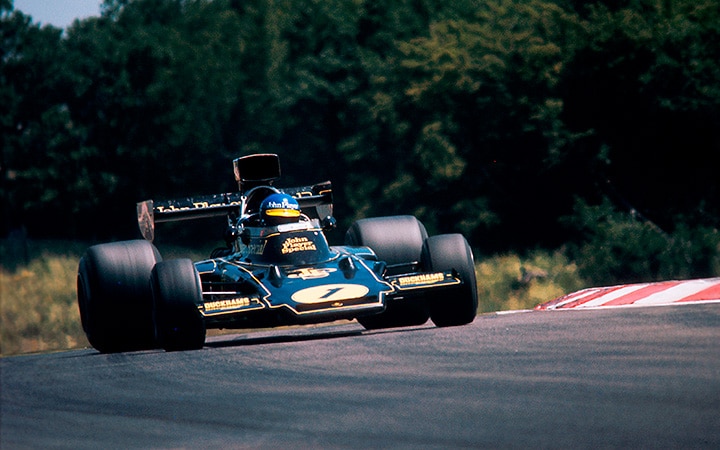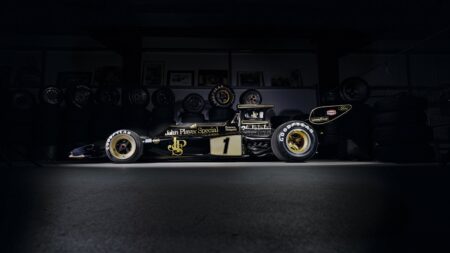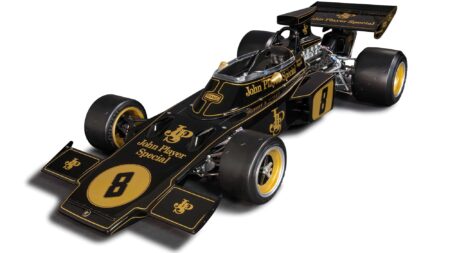The shunted E-spec 72, chassis R8, built for the start of 1973, had already won in Monaco (setting fastest lap) and at Dijon (from second on the grid) in Peterson’s gifted hands. Repaired, it was taken to Monza as a stand-by while the team again chanced its 76s.
Peterson was back in R8 by the second practice session of Friday – and lapping 1.3sec faster than he could in his 76. Though persuaded to give the latter another go on Saturday – he went slower still – he would race R8 and start from seventh on the grid.
Lotus 72 was the car they couldn’t hang.
Though not on the single-lap pace of the more powerful Ferrari 312B3s of pole man Niki Lauda and Clay Regazzoni, nor that of the Brabham BT44s of Carlos Reutemann, Carlos Pace and John Watson – designer Gordon Murray was beginning to tap into underbody downforce and so was able to utilise a shallower rear wing – the venerable 72 was fast in a straight line due to its narrow track and boasted good traction thanks to its rearward weight bias. Though these design criteria were going out of fashion, they would at least keep the warhorse in the race’s mix at slippery-quick Monza, even though the track’s stream had been dammed by a couple of chicanes.
Lauda jumped the gun at a typically chaotic start and held a sizeable lead by the end of the opening lap. Peterson was sixth, having picked off the McLaren M23 of Emerson Fittipaldi.
On the next lap Peterson followed Regazzoni past Watson, who was hampered by too strong a rearward brake bias in the works car loaned him after a broken wheel had pitched his Goldie Hexagon Racing-run version into the barriers on Saturday.
The weather was scorching and Brabham’s woes continued when Pace pitted early to replace a shredding rear, this despite Goodyear’s switch to a previous spec just prior to the start. The 72, with its lightly loaded nose and inboard brake discs, struggled increasingly to put heat into its front tyres – it had originally been designed for bespoke Firestones – but this was not a worry today.
Regazzoni had passed Reutemann for second place by the time the latter’s gearbox failed, and the Ferraris circulated comfortably at the front – until Lauda’s flat-12 emitted an ominous puff of smoke at half-distance. The problem was terminal. Regazzoni took the lead and held it for 11 laps, whereupon he, too, began to pipe a contrail.
Alerted to the possibility of a victory, Fittipaldi outbraked Peterson into the first chicane. But he outbraked himself, too, and was immediately repassed. He would not try again. Once Regazzoni, the championship leader, had retired, the Brazilian chose to exert pressure on the new leader rather than risk a pass – for a no-score would have been disastrous in this most competitive of seasons.
A discordant loose tail pipe caused Team Lotus some concern, but Peterson had it under control, even though he won by less than a second in a repeat of the previous year’s finishing order.
His was a victory popular with Motor Sport reporter Denis Jenkinson, who, as always, did not hide his sentiments:
Had the situation been reversed on the last lap, there would have been some do-or-die tactics… with some really desperate stuff on the final corner and up the finishing straight. As it was, Peterson knew he had it made, for Fittipaldi [is not] one to throw caution to the winds and let passion override sound business acumen.
From the day when Peterson started with March he has known only one way to drive, and that is as hard as he can go. He is not one for trailing around at the back of the field, wittering about his tyres, or his engine, or the handling of his car. He is a racing driver of the best sort and earns every penny he gets.



